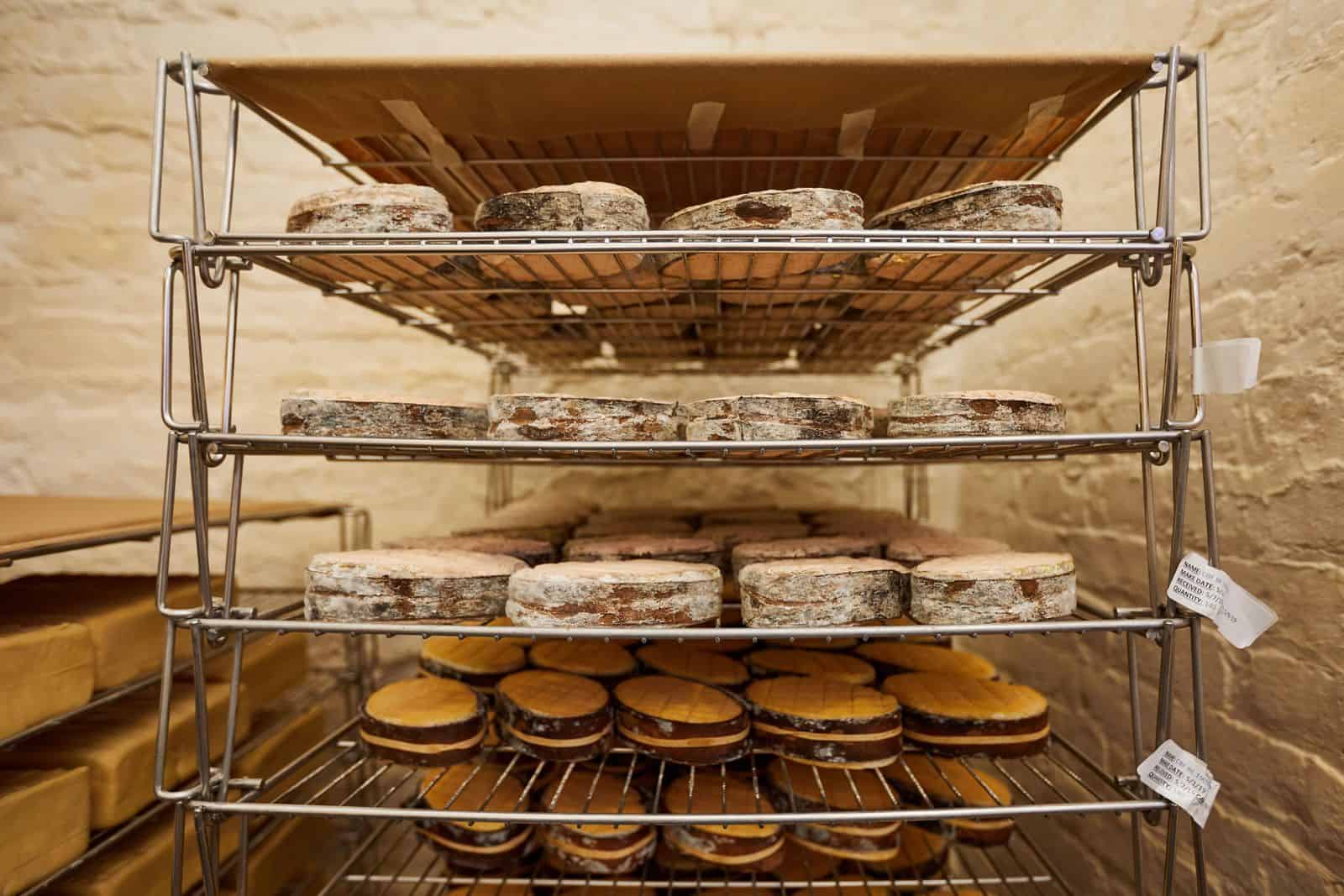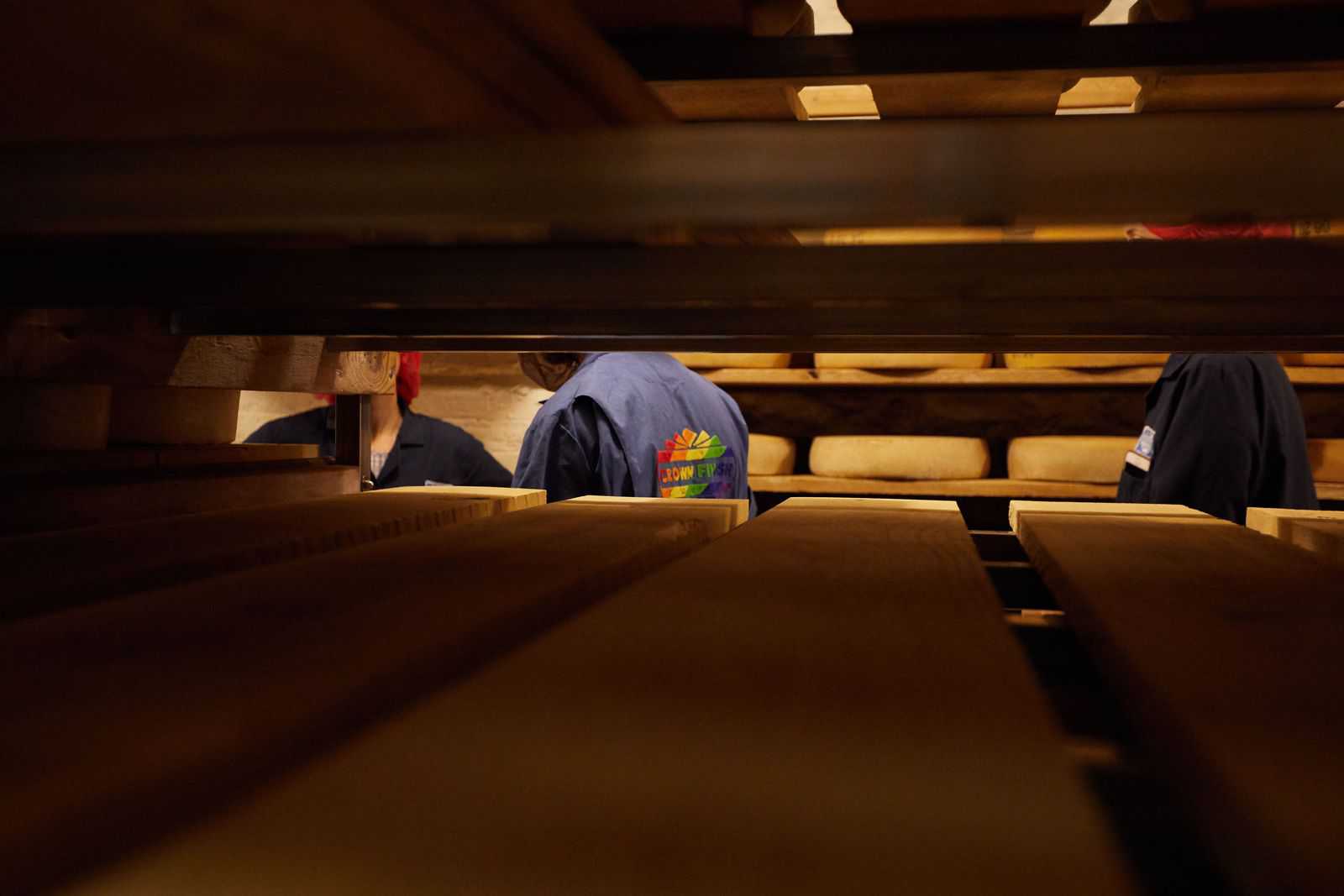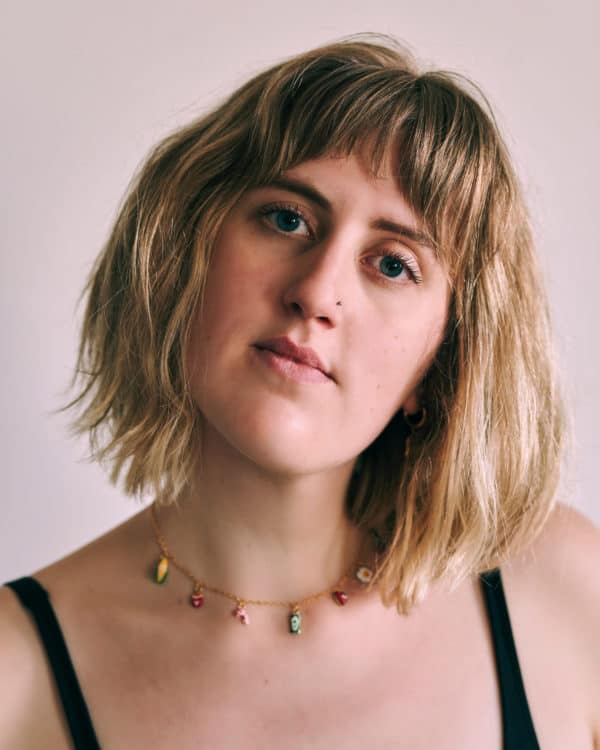
I’m staring at a nondescript dark blue garage door somewhere in Brooklyn’s Crown Heights neighborhood. It’s the first Saturday of New York City’s week-long Pride celebration and the streets are buzzing with rainbow-clad revelers. I approach the door slowly, then stop when I see another woman rushing over with keys and phone in one hand, canvas tote in the other.
This is Caroline Hesse, part head of sales, part creative team, part events manager, and part whatever-else-needs-to-happen at Crown Finish Caves. She waves me over, we hug, and next thing I know I’m inside the pristine Crown Finish office, complete with a floor-to-ceiling chalkboard wall—more on that later. Just as I settle onto the white pleather couch, the door swings open and in walks head affineur Ethan Partyka, who looks just like you’d imagine a bicycle-tech-turned-affineur would. (Read: cool tattoos, cool hat, and general Cool Guy aesthetic. I instantly want to be his friend.)
I take in my surroundings as Hesse and Partyka situate themselves opposite me, the chalkboard wall acting as their backdrop. “So what’s going on behind you?” I blurt out before I remember to hit record on my phone. Partyka smiles and explains the wall is essentially their production calendar for what’s currently in the cave; this is where they track the lifecycle of cheeses from the time they arrive to when they’re ready for distribution.
Crown Finish Caves is a facility for cheese aging, a practice known as affinage (French for “maturing” or “refining”). Aging takes place in one of their two caves—climate-controlled caverns 30 feet below the streets of Brooklyn.
Unlikely Origins
Old-school metal filing cabinets, a pair of vintage brown chairs, and a utilitarian desk (complete with a bumpersticker that reads “ELECT WOMEN”) are the only real furniture in the long, narrow office. Amidst the neatly arranged binders in the windowsills, I notice small, hand-drawn pictures of people and cheese. Vibrant posters and framed photographs bring pops of color to the otherwise monochromatic room.
Nothing about this well-organized space seems planned, and Hesse confirms that most of Crown Finish Caves’ origin was happenstance.
“There wasn’t a plan for the caves,” she explains. “[The owners], Benton [Brown] and Susan [Boyle], bought this building and the one behind it in 2001. Susan has a background in… actually, I don’t even really know.”
Partyka laughs and chimes in. “Susan’s background is in eco stuff like transportation alternatives; she’s very focused on green efforts,” he says. “And Benton’s background is in art—both as an artist and in handling art—so they formed a construction company together.”
“These two buildings are super old,” Hesse continues, referring to the room we’re sitting in and the adjacent ice house, originally used by the building’s 19th century tenant, Nassau Brewery, as cold storage up until prohibition. “[Benton and Susan] just wanted to turn [the ice house] into a residential unit to live in, but the owner at the time was like ‘You have to buy both’ because it’s connected by a courtyard. So they did.” And the caves, formerly used to brew beer, were also part of the deal.

I pause for a moment. I’m surprised, though perhaps I shouldn’t be, to learn that neither of the founders have backgrounds in cheese. The particular skill set required for affinage seems like the kind of niche knowledge you’d seek out rather than fall into.
“I graduated with a liberal arts degree in religious studies,” Hesse reveals. Slightly confused and simultaneously delighted by the similarities to my own unconventional trajectory, I press Hesse for more details.
“[After graduating] I was really freaking out, and was like ‘I’m just gonna relax and get a job at a cheese shop until I figure out what I’m going to do,” she says. Hesse’s cheese shop job led to a brief stint at a dairy where she quickly realized she wasn’t a farmer. After returning to New York, she started at Crown Finish as an intern. And she never left.
Partyka’s path to affinage followed a similarly winding route: a liberal arts undergraduate degree led him to pursue a Craigslist ad for bike shop help, which brought him to culinary school, naturally. Culinary school “wasn’t really his thing,” so Partyka left to work at a specialty food shop and eventually ended up as an apprentice at Crown Finish. Three years later, Hesse and Partyka are steering the ship, er, cave.
Making Space
Developing Brooklyn-based affinage also took time and a bit of circuity. After purchasing the buildings in 2001 and living there for almost a decade, Brown began taking cheese classes with dairy consultant Peter Dixon. It sparked something irrevocable in Brown—like many entrepreneurs, he saw a gap in the existing cheese world: space.
“By talking with cheesemakers throughout [all phases of the] process, again and again [Brown] was hearing cheesemakers say they don’t have enough room to age their cheese,” Partyka says. Enter their inherited brewery caves, which have the perfect conditions for affinage.
Brown and Boyle broke ground in 2011, and while construction was underway, they continued to absorb as much cheese knowledge as possible. In the years that followed, Brown crowdsourced advice, recipes, and more from the likes of Jasper Hill Farm’s Mateo Kehler and world-famous affineur Hervé Mons. Meanwhile, he worked with the folks at Clauger—an industrial refrigeration and air-conditioning company known for their custom-built systems—to craft a solution for maintaining an optimal cheese aging environment in the caves.
Going Underground
To enter the caves, you prepare as you would for brain surgery: hand washing, hair nets, cave-specific boots, lab coats, the whole nine yards.

I scrub up, slip on a pair of boots, and prepare for the descent down the steep spiral staircase. As though reading my mind, Partyka points to the freight elevator door, explaining that’s how they haul cheese between floors. Clutching the railing, I make it to the base of the stairs and am met with more gadgetry. Partyka proudly guides me through a brief tutorial of the Clauger machine, designed specifically for Crown Finish back in 2012, that regulates the temperature and air pressure in the cheese cave.
“Because we’re 30 feet underground, the cave is naturally very cold and damp, but to be a licensed dairy plant we need something regulating and recording all of our daily temperatures,” Hesse explains.
“And the cheese, as it ages, is alive,” Partyka says as he excitedly gestures towards the machine’s screen. “It has a metabolism and is releasing heat, so we need to introduce artificial cooling, [which means] we’re actively robbing humidity from the air and need to reintroduce that humidity.”
I nod along, pretending to comprehend all the technical terms they’re using. Then, the moment of truth arrives. Hesse pushes back the large metal door and suddenly, as promised, I’m staring into a cheese cave 30 feet below the streets of Brooklyn.
The cave’s smell is relatively mild, like a clean mold, which I’m told is purposeful. “We’re controlling the rate at which we introduce air into the cave, so we’re not in a stifling ammonia- and methane-filled environment,” Partyka says. “Some caves are like walking into a cat hoarder house and your eyes tear up immediately.”
It’s easy to imagine the smell situation escalating when you consider all that’s going on in the cave; The cheeses release methane gas, the Cluger pumps in air and humidity, and at the same time, countless molds are growing on the many wheels they’re housing.
Green to Great
Cheese is sent to Crown Finish from various national producers (like Old Chatham Creamery in Old Chatham, New York, and Spring Brook Farm in Reading, Vermont) and one international producer (Quattro Portoni in Italy) in varying quantities—sometimes makers send a few wheels for experimenting, and other times they send enough cheese for retail distribution. Crown Finish receives “green” cheese, which means it’s fresh out of production. Then, Partyka and his assistant let nature work its magic.

“There’s only so much that we can control [about the cheese]—we can brush it, we can wash it, but we have a very limited set of tools,” Partyka says. “It’s like you inherit a garden and all you need to do is weed and water it.”
This is part of what makes Crown Finish so unique. In some cases, they’re letting the cheeses and ambient mold in the cave do their thing, and in others they’re adding to the process.
“The cheese is already on a very predetermined path by the time we receive it,” Partyka says as he leads me through the cave, single file. “Everything that goes into the main process [pushes] the cheese in a particular direction: style, moisture, pH, fat content. Our job is to help that cheese [develop] in the direction it already wants to go in.”
Partyka shows me two drastically different cheeses, seemingly similar only in their square shape. These cheeses, Natural Rind Bufarolo and Washed Bufarolo, begin as the exact same green cheese imported by Quattro Portoni from Gritti Family Farm in Italy. Natural Rind—a silvery cheese with a mushroomy, earthy taste—is allowed to do its thing and mingle with the ambient cave mold. By contrast, Washed Bufarolo is firsthand-washed in brine, then in a mixture of brine and beer (often locally brewed), giving it a yeasty orange rind and a fatty paste sans earthiness.
Beyond Bufarolo, the cave is filled with a variety of cheese styles, such as Trifecta, a mixed-milk triple cream, and Tubby, a large-format Alpine style. A section of vibrant cubes catch my eye—this is Barnburner, a smoked cheddar style made by Grafton Village Cheese in Vermont. The youngest blocks are bright orange and dotted with a few bits of greenish mold, while the oldest are completely covered in mold and look like hunks of marble. When the cheese arrives at Crown Finish, it’s rubbed with lard, bandaged, then aged four or more months in the cave. The result? A gorgeous yet approachable cheese with notes of smoke, tang, and meat.
Is Crown Finish Caves Brooklyn’s best-kept secret? Maybe so. “I think in the cheese world, we’re known—but in our neighborhood, we’re kind of a whisper,” Hesse says. It certainly feels magical—a tour de force of American affinage, all made possible by a series of very fortunate events that lead an artist, eco-activist, religious scholar, and former bicycle technician into the world of curd.








A wonderful article, Madison!!